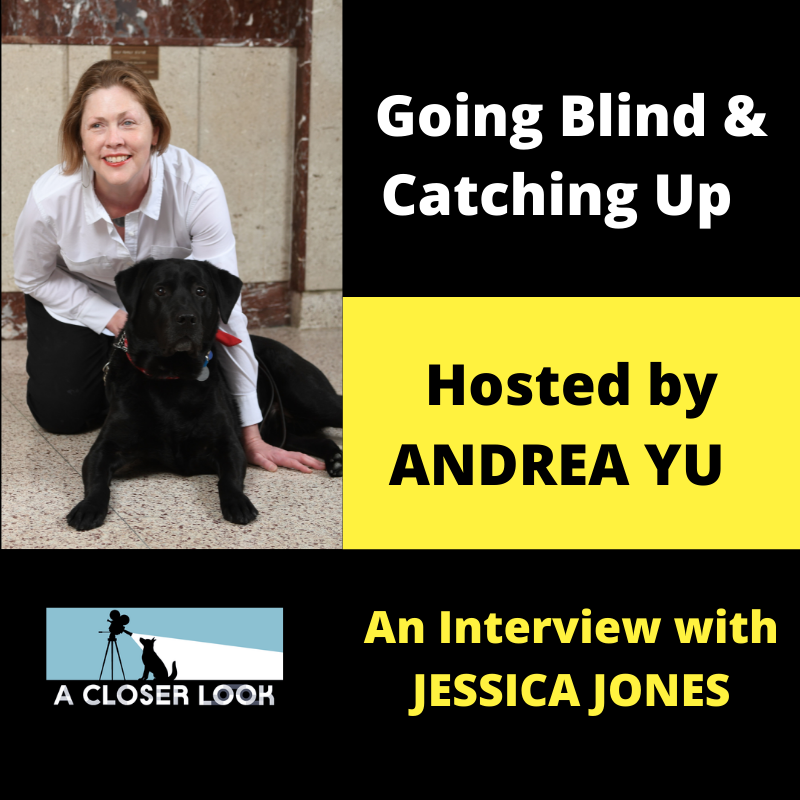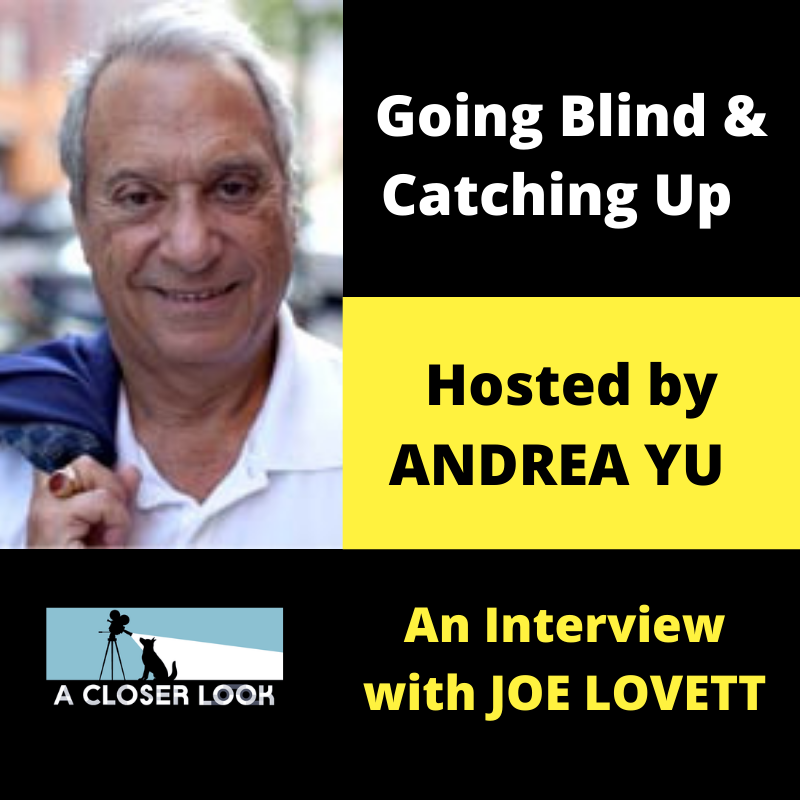
Going Blind & Catching Up with ANDREA YU:
An Interview with JESSICA JONES
May 28, 2021
A year after the start of a global pandemic, Andrea Yu, who is a student with City Access New York interning with A Closer Look Inc., spearheaded a series of interviews with characters from Going Blind (2010) to find out how they fared through a year of COVID-19 lockdown and where they are now in their sight-loss journeys.
Up first, Andrea spoke with Director Joe Lovett, who reflects on his life and vision and offers a glimpse into the lives of the characters you’ll hear from in the coming weeks.
To listen to the interview, visit A Closer Look Inc.’s Soundcloud by clicking here.
To view the film, Going Blind, click here.
ANDREA YU: Hey everybody, this Andrea Yu. For the second episode of Going Blind & Catching Up, I interviewed Jessica Jones. We talked about how she, her students, and her guide dog Willie during this pandemic.
Hello Jessica. In the film Going Blind, you said you have diabetic retinopathy and you work as a teacher and a photographer. So how have you been during this time with this pandemic?
JESSICA JONES: It’s been very interesting. If you know teachers other than myself, I’m sure that you have heard about the difficulties of teaching remotely. It adds a little extra piece of this fun puzzle that we’re living in with teaching remotely. In my school, we don’t use zoom with our students. We use an application called Google classroom.
\When you have any sort of speech software on a computer or on my phone, that speech software takes up so much space and it’s doing so much work. Sometimes it seems almost in a juxtaposition to different applications that you have going and the majority of them work incredibly well. Since Apple products came out, where we are with being able to use the Internet effectively is astounding. I got my first iPhone 10 years ago and it completely changed my life as far as technology goes. You know, with Google Classroom, JAWS does not work well with it, and I can do all of the rudimentary things, such as going online, meeting up with my students, presenting a lesson, etc., and so forth. With more advanced applications within Google Classroom, there are still some things, because the speech software that I use on a computer is called JAWS. JAWS and Google Classroom don’t work very well together. So it has been a constant learning experience. Of course, Google does updates so so frequently. Every time you figure something out, it changes. Again, in that juxtaposition between Google classroom and JAWS, teaching has been very very interesting and very very frustrating at times, but I’m still doing it! I’m hanging in there.
AY: Right, I can imagine with all these technological difficulties. I would assume it is more accommodating than other platforms like WebEx, Zoom, or Blackboard Collaborate though?
JJ: Well, Zoom I find to be much much more accommodating.
AY: How so?
JJ: It doesn’t seem to be the same battle going on. For example, you know the speech software that I use on my phone is VoiceOver. The one I set on my computer is JAWS. There doesn’t seem to be the same battle going on between VoiceOver or JAWS and the Zoom application. Speak to any fully-sighted teacher that you meet and they’re going to tell you that Google Classroom is difficult as well. It’s just that extra layer of difficulty that JAWS provides that’s a little intimidating.
AY: Right. Since you are facing such issues with these technologies in your teaching job, how is photography going for you?
JJ: Honestly, I have not done any photography since the pandemic started. I’m not going to have anybody into my home to do it. Usually, we work in groups, because I cannot see through the camera. You know, I need to make sure that the shot that I am setting up is exactly what I want it to be. Getting together in groups like that is impossible right now.
AY: Right. So what have you been doing instead of photography?
JJ: As far as art, I like to build. I am constantly building something either on my own for my own satisfaction or with my students.
AY: What do you like to build?
JJ: I think the real question is what don’t I like to build. I like going from one extreme, you know, doing things that are figurative to things that are more abstract and simply just putting objects together that I find pleasing in a combination that I find pleasing.
AY: So somewhat like sculpture.
JJ: Yes. The only tool that I no longer weld or use the blowtorch.
AY: Oh right that is quite dangerous.
JJ: Yes.
AY: Do you also do other kinds of sculpture, like with polymer clay?
JJ: With clay, with paper mache, with wood, with like I said found objects. I pretty much do everything.
AY: So you’re quite active in this time.
JJ: Yeah.
AY: Wow. How has your vision been treating you?
JJ: How has my vision been treating me…Well like I said, I don’t have any vision, so I’m not quite sure I understand your question.
AY: Ah, more like…since the pandemic started, people have been hesitant to go to their eye doctors to attend their appointments, so they do not have as much access to their treatments.
JJ: I understand what you’re saying. In the beginning, before anybody knew more about this virus, all of my doctors’ appointments were over the phone, or over Zoom, or over FaceTime. Since we have come to know more about the virus and what you can and you cannot do, I am now making doctor’s appointments in person. Beside that, I feel more confident. I had an advanced vaccination more than a month ago, so I feel pretty confident. Not 100%, for sure, because we still don’t know if you got the vaccinations and you can still be a carrier, things like that. But I feel much more confident than I did.
AY: Oh, that’s good then. You are quite capable during this time.
JJ: Yes, I still have Willie who I’ve got to take care of. I don’t have a choice in that and I’ve always found it difficult to be told that I cannot do things – Willie got very tired of not working. He needed to do things, he’s a working dog. That is what makes him happiest. And so, I had to figure out a way to get him out and doing things. Very much against my mother’s better judgment, I started scheduling walks very very very early in the morning and very very very late at night. So of course at that point, I was not going inside of the grocery store, the post office, or anything like that. But at least Willie was out and guiding me and working. Like I said, that’s truly what makes him the happiest.
AY: So then you accommodate him, while he does the same for you and you can both enjoy your time together.
JJ: Absolutely, yeah. You know what? That’s a really good way of saying it! Andrea, yes.
AY: So then nowadays, have you guys continued taking these walks?
JJ: Oh sure. Wednesdays are still remote, just so that in the middle of the week, the school can be thoroughly sanitized from top to bottom. You know, we’re doing that constantly as we work with the students. There is no sharing of paintbrushes and scissors anymore. One child uses the paintbrush, then I’ve got to sanitize it before another child picks it up. So we are completely back at work, but like I said, still having our remote classes on Wednesdays.
AY: You guys are very cautious during this time, which is good, and how have you been accommodating the students though?
JJ: Well, we still have about 50% of our students whose parents find they are not yet ready to put their children back in school, and that will continue throughout summer school. And then beginning next September 21, it will be mandatory for all students to be back in school for in-person learning. So a good 50% of my students, we are still working with them remotely along with the students that are physically in school 4 days a week.
AY: Right. How are you all preparing for that though once everyone comes back? Are you still going to take precautions?
JJ: Oh, absolutely. Precautions will be taken. I am quite sure that the extra sanitation will continue. I know personally on my part, the extra sanitation will continue. We have not yet received a game plan in writing from the superintendent of the school as to how exactly things will be done come September. But I do know that on a personal level, I will continue with the personal sanitation that I’m doing with our tools.
AY: You are all working very hard to keep everyone safe and that’s a really good thing. That’s very admirable, because a lot of people nowadays, well, they don’t seem to take as much precaution as you.
JJ: Oh, I agree with you. Absolutely.
AY: Right, so just hearing this from you, it’s hope that the pandemic will end, hopefully sooner than what we expect.
JJ: Hopefully, fingers crossed. Fingers and toes crossed.
AY: Right. Well, it was great hearing from you and how everything seems to be going great!
JJ: Oh, thank you so much. I really do feel that things are looking up.
AY: For sure. Thank you for speaking with me today.


Recent Comments